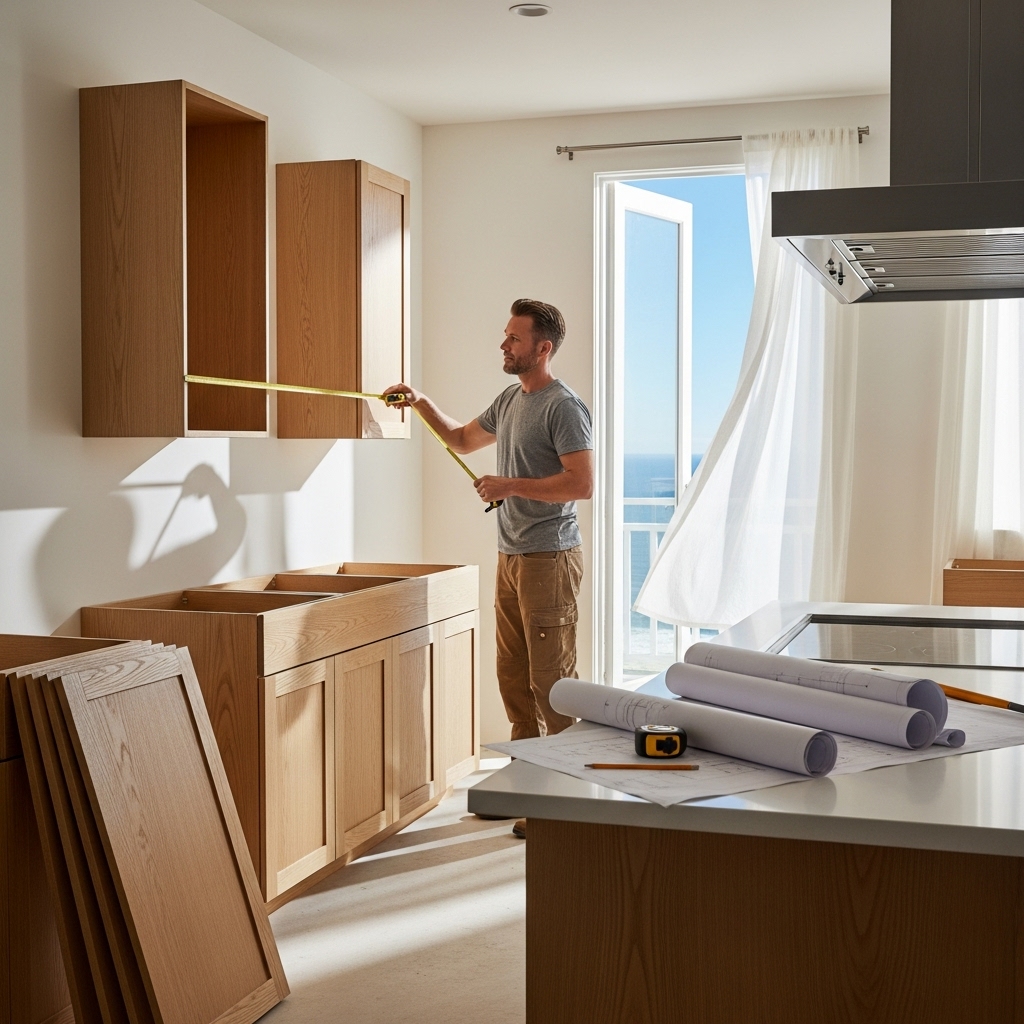It’s tempting to compare kitchen remodeling cost per square foot as if it were a simple yardstick. In Huntington Beach, though, that metric rarely tells the full story. Homes here span mid-century ranches, split-levels, townhomes near the coast, and custom properties tucked around Huntington Harbour. Each type brings unique framing, access, and finish expectations. So while square footage helps us calculate material quantities, it doesn’t fully capture the choreography of design, structural work, utilities, and craftsmanship that shapes a project’s real scope and experience.
When locals begin to explore kitchen remodeling, the conversation quickly moves beyond a simple per-foot figure. The meaningful questions become about function, layout evolution, material resilience in a coastal setting, and the feel you want every time you turn the corner into the room. Averages can be a starting point, but they’re not a compass; what guides us is how you cook, gather, and live day to day.
Why cost per square foot falls short
Square foot metrics assume uniformity. Kitchens, by contrast, are the opposite—they compress complex mechanical systems, appliances, and millwork into a relatively small area. Ten linear feet of cabinetry with integrated pullouts, a paneled refrigerator, and a built-in coffee station can carry more design and labor than a much larger but simpler layout. The per-foot number doesn’t account for whether a wall needs a beam, if a gas line must be relocated to serve an island range, or whether your design calls for slab backsplashes and mitered edges that demand expert fabrication.
Layout and structure matter most
When you move a sink, you change plumbing. When you relocate a range, you alter ventilation and electrical. Remove a wall and you engage engineering. These decisions set the baseline for both schedule and investment. In neighborhoods near the beach, ceiling cavities can be shallow, making duct runs more involved. In older homes, you may discover legacy wiring that warrants updating. Understanding the structural map and the home’s existing systems early provides clarity; it also prevents surprises that can cascade through a timeline. The right plan respects the bones of the house and elevates how the space works.
Cabinetry: the heart of the kitchen
Cabinets occupy a small footprint, but they define storage, ergonomics, and the room’s visual rhythm. From semi-custom lines with robust options to fully custom builds, the choices here run deep. Full-height pantries, drawer bases instead of doors, appliance panels, and internal organizers change the game in everyday use. Finish decisions—paint versus stain, natural wood species, and sheen level—add another dimension. These selections influence fabrication time, coordination with counters and splash, and the care needed during installation to deliver a flawless result.
Counters, splash, and surfaces
Surface choices shape both feel and function. Slab countertops bring crisp lines and generous work areas; a waterfall detail on the island can anchor the entire composition. Backsplashes can be as subtle as a hand-glazed field tile or as dramatic as book-matched stone. In coastal environments, it helps to think about maintenance and durability. Selecting surfaces that resist etching, staining, or swelling keeps the kitchen looking fresh even with heavy use after beach days and weekend gatherings.
Appliances and ventilation
Selecting appliances is less about checking boxes and more about aligning with how you cook. Do you want a pro-style range or a separate cooktop and wall oven for ergonomic flexibility? Is a speed oven a better fit for quick weeknight meals? Ventilation deserves equal attention: correct sizing, quiet operation, and a clean path to the exterior make a huge difference in comfort. The per-square-foot lens misses these nuances entirely, but they are central to how the kitchen performs and how enjoyable it is to spend time there.
Electrical and plumbing: the hidden essentials
Code-compliant outlet spacing, dedicated circuits for large appliances, and updated wiring are nonnegotiable in a modern kitchen. GFCI and AFCI protections, under-cabinet lighting feeds, and dimming for layered lighting belong in the design plan from day one. On the plumbing side, reliable supply lines, shutoffs, and venting underpin sinks, dishwashers, pot fillers, and filtered water taps. These systems are rarely visible in photographs but are vital for safety and longevity. Again, none of this fits neatly into a square-foot equation.
Permitting and inspections in Huntington Beach
Permitting aligns the project with life-safety and energy codes. When exterior changes are involved, additional reviews may apply, especially in sensitive coastal areas. Strong documentation and early coordination mean fewer interruptions after demolition. Seasoned teams understand local expectations and sequence inspections so work continues smoothly, which helps keep momentum consistent from framing to finish.
Access, logistics, and schedule
Logistics make a tangible difference in day-to-day progress. Narrow side yards, second-floor kitchens, or tight cul-de-sacs can influence how deliveries arrive and how debris leaves. Protecting floors, managing dust, and staging materials safely all take planning. Kitchens are compact hubs for multiple trades; a precise schedule keeps cabinet installers, electricians, and tile setters from tripping over one another. The right rhythm is part of cost control, though it rarely shows up in per-foot calculations.
Design intent as the north star
Great projects are anchored by a clear concept. Whether your home leans modern coastal, California casual, or a warm transitional blend, coherence across cabinets, counters, splash, hardware, and lighting elevates the whole. Mood boards, samples under real light, and mockups help refine details before they’re permanent. When decisions are made with intention, the finished kitchen feels inevitable—like it always belonged in the home. That sense of rightness is a hallmark of thoughtful planning and careful execution.
Resilience for coastal living
Salt air, breeze-driven moisture, and sandy feet are facts of life in Surf City. Planning for corrosion-resistant hardware, stable substrates, and durable finishes ensures the kitchen ages gracefully. Proper exterior venting, reliable weather seals around new openings, and smart caulking details play quiet but important roles. Resilience doesn’t mean compromising aesthetics; it means choosing products and assemblies that keep beauty intact year after year.
Working with a local expert team
Experience across Huntington Beach neighborhoods offers more than name-dropping; it brings pattern recognition. It means anticipating which 1960s tracts hide junction boxes in odd places, or which vaulted ceilings require creative ducting solutions. Midway through your planning process, consider what you need from a partner: design clarity, construction expertise, and a culture of communication. That combination is where the real value lies in kitchen remodeling, because it keeps choices aligned with your goals while protecting schedule and quality.
Thinking beyond the number
Instead of asking “What’s the cost per square foot?” a better question is “What will it take to create a kitchen that supports our daily life and feels right in our home?” When we shift the conversation, we make room for flow, light, ergonomics, and durability—the qualities that matter every single morning. We also make room for your unique wish list: the built-in breakfast bench where homework happens, the second sink that keeps prep and cleanup separate, or the walk-through pantry that streamlines entertaining without clutter.
Frequently Asked Questions
Is cost per square foot useful for kitchens?
It’s a rough reference for material quantities, but kitchens concentrate mechanical systems and craftsmanship, so the number rarely reflects the full picture. Layout complexity, selections, and site conditions have a larger impact on the overall plan.
What influences kitchen costs the most in Huntington Beach?
Structural changes, utility relocations, cabinetry quality, and finish choices are major drivers. Local permitting and logistics also matter, especially in homes with limited access or special coastal considerations.
How can I make the most of my budget without focusing on per-foot numbers?
Prioritize function and the design elements you’ll use daily. Decide early on big-ticket choices like layout, cabinetry style, and appliance configuration. Keep alternates in mind for finishes to maintain design intent if availability shifts.
Will I need permits for a kitchen remodel?
Most projects that alter electrical or plumbing require permits. If exterior changes are planned, additional reviews may be necessary. A well-prepared plan set and early coordination with the city simplifies the process.
Can we live at home during construction?
Many families do. With dust control, a temporary kitchenette, and a clear schedule, living in place is manageable. Communication about utility interruptions and delivery days keeps daily routines on track.
Ready to plan a kitchen that fits your home, not a formula?
If you’re ready to trade generic metrics for a plan tailored to your home and lifestyle, start a conversation with a local team that understands the nuances of Huntington Beach. Walk the space together, refine the design, and map out a realistic path from concept to completion. When it’s time to begin, connect with trusted experts in kitchen remodeling and take the first step toward a kitchen that truly works for you.

